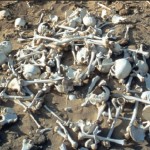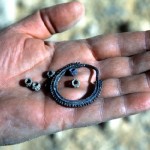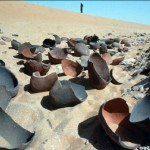 A pair of Italian archaeologists investigating the Sahara desert near Siwa in Egypt have uncovered hundreds of bleached bones, Bronze age weapons, arrowheads, jewelry, water pots and other artifacts dating to the 6th century B.C., right around the time when Persian king Cambyses II lost himself an army of 50,000 trying to destroy an oracle denying his right to rule a conquered Egypt.
A pair of Italian archaeologists investigating the Sahara desert near Siwa in Egypt have uncovered hundreds of bleached bones, Bronze age weapons, arrowheads, jewelry, water pots and other artifacts dating to the 6th century B.C., right around the time when Persian king Cambyses II lost himself an army of 50,000 trying to destroy an oracle denying his right to rule a conquered Egypt.
The earring and a bridle fitting look very much like carved images of Persian soldiers from the period. The bronze dagger fits the era and culture as well. These are unique finds.
 Herodutus (484-425 B.C.) wrote about Cambyses and his doomed campaign, felled by a sandstorm on the way to the oracle at the Temple of Amun near the Oasis of Siwa, but no physical evidence of the event has ever been found before. The desert doesn’t really get excavated a lot, for obvious reasons.
Herodutus (484-425 B.C.) wrote about Cambyses and his doomed campaign, felled by a sandstorm on the way to the oracle at the Temple of Amun near the Oasis of Siwa, but no physical evidence of the event has ever been found before. The desert doesn’t really get excavated a lot, for obvious reasons.
“It all started in 1996, during an expedition aimed at investigating the presence of iron meteorites near Bahrin, one small oasis not far from Siwa,” Alfredo Castiglioni, director of the Eastern Desert Research Center (CeRDO) in Varese, told Discovery News.
While working in the area, the researchers noticed a half-buried pot and some human remains. Then the brothers spotted something really intriguing — what could have been a natural shelter.
It was a rock about 35 meters (114.8 feet) long, 1.8 meters (5.9 feet) in height and 3 meters (9.8 feet) deep. Such natural formations occur in the desert, but this large rock was the only one in a large area.
“Its size and shape made it the perfect refuge in a sandstorm,” Castiglioni said.
Right there, the metal detector of Egyptian geologist Aly Barakat of Cairo University located relics of ancient warfare: a bronze dagger and several arrow tips.
“We are talking of small items, but they are extremely important as they are the first Achaemenid objects, thus dating to Cambyses’ time, which have emerged from the desert sands in a location quite close to Siwa,” Castiglioni said.
Cambyses was the son of Cyrus the Great. He took out his daddy issues on Egypt, which Cyrus had planned to invade but died before he got the chance. In 525 B.C., Cambyses defeated Pharaoh Psamtek III, the last king of the 26th Dynasty. Cambyses’ stint as the first pharaoh of Egypt’s 27th Dynasty ended 3 years later when he died on his way home to Persia.
 The sources on all this are thin, to say the least. Herodotus being a Greek had a tad of a bias against the Persians, what with the continual wars going on between them from the time of Cyrus the Great to a hundred years later when Herodotus was writing.
The sources on all this are thin, to say the least. Herodotus being a Greek had a tad of a bias against the Persians, what with the continual wars going on between them from the time of Cyrus the Great to a hundred years later when Herodotus was writing.
Cambyses’ failures may not actually have included his soldiers having to eat their dead comrades to survive in Nubia and losing a 50,000 man army in the desert.
Mohammed al-Saghir of Egypt’s Supreme Council of Antiquities is organizing another expedition to the site to investigate it more thoroughly. The desert sand can be a fine preserver of delicate items like textiles and leather. Whether these are the remains of Cambyses’ lost army, the kernel of truth behind the tale, or another thing altogether, any finds could tell us a huge amount about the military and political history of the time.